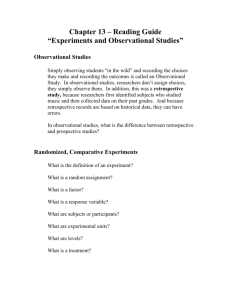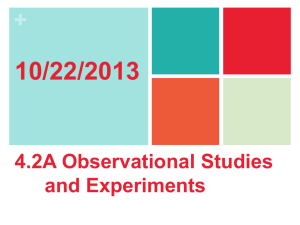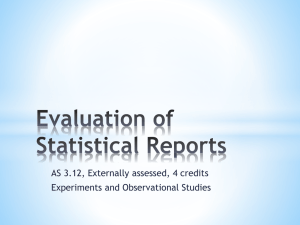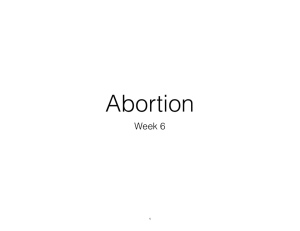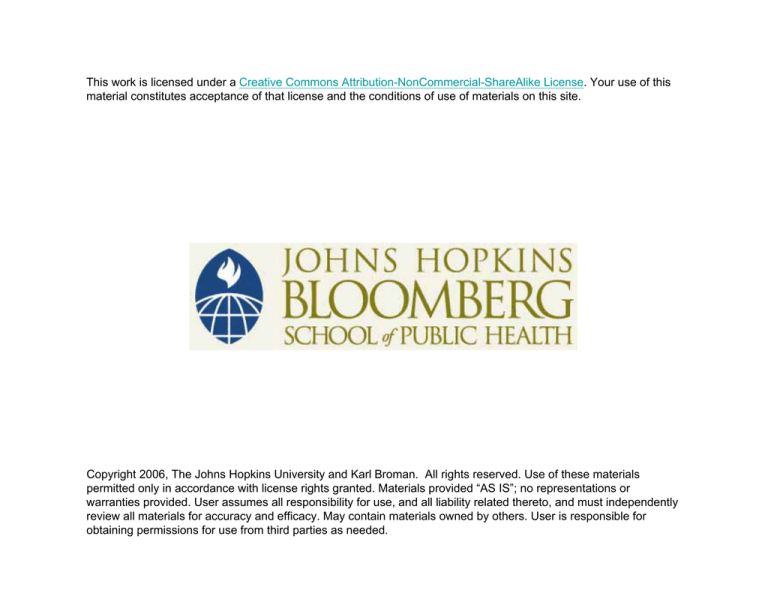
This work is licensed under a Creative Commons Attribution-NonCommercial-ShareAlike License. Your use of this
material constitutes acceptance of that license and the conditions of use of materials on this site.
Copyright 2006, The Johns Hopkins University and Karl Broman. All rights reserved. Use of these materials
permitted only in accordance with license rights granted. Materials provided “AS IS”; no representations or
warranties provided. User assumes all responsibility for use, and all liability related thereto, and must independently
review all materials for accuracy and efficacy. May contain materials owned by others. User is responsible for
obtaining permissions for use from third parties as needed.
Observational studies
Controlled experiment:
The investigator chooses who receives the treatment.
Observational study:
The subjects themselves choose whether they receive the
treatment.
Key issues:
• Correlation (association) is not causation.
• Confounding
• Simpson’s paradox
The clofibrate trial
Coronary drug project: A randomized, controlled, doubleblind experiment to evaluate 5 drugs (including clofibrate) for the prevention of heart disease.
Subjects: Middle-aged men with heart trouble.
• 5,552
assigned at random to the drug groups
• 2,789
assigned at random to the control group
(placebo=lactose)
• Patients
followed 5 years.
Note: most examples taken from Freedman,
Psiani, Purves (1998) Statistics, 3rd ed, Ch 2
Clofibrate
• Reduces
the level of cholesterol in the blood
• Didn’t save any lives in the trial:
– 20% dead in clofibrate group
– 21% dead in control group
• Possible
cause: adherence
(Many subjects didn’t take their medicine.)
• In clofibrate group: [Adherer: took >80% of medicine.]
– Adherers: 15% mortality rate
– Non-adherers: 25% mortality rate
Adherence in the clofibrate trial
Clofibrate
Number
Deaths
Adherers
708
15%
Non-adherers
357
25%
Overall
1,103
20%
Placebo
Number
Deaths
1,813
15%
882
28%
2,789
21%
Adherers and non-adherers differ in ways other than
whether they took their medicine!
Conclusion: Clofibrate has no effect.
Causes of association
Suppose A is associated with B.
This may be because:
•A
causes B
•B
causes A
•X
is associated with both A and B.
Confounding
In the association of A and B, X is a confounder if it is
associated with both A and B.
X need not be a cause of either A or B.
For example, in the consideration of smoking and lung cancer, a
gene which
• causes smoking but is not associated with lung cancer is
not a confounder.
• causes lung cancer but is not associated with smoking is
not a confounder.
• causes lung cancer and is associated with smoking is a
confounder.
Disease P——
• First observed in Europe in 18th century; important cause of ill-health,
disability and premature death among the very poor. Spread across Europe by
the beginning of the 19th century.
• It seemed to hit some villages more than others; many households were
spared, but some had disease cases year after year.
• Sanitary conditions in diseased households were primitive. Flies were
everywhere.
• One blood-sucking fly (Simulium) had the same geographical range as the
disease, at least in Europe, and was most active in the spring, when most of
the cases developed.
Many epidemiologists concluded the disease was infectious and—
like malaria, yellow fever, or typhus—was transmitted from one
person to another by insects.
Was this conclusion justified?
Discussion
Cervical cancer and circumcision
• Cervical cancer was for many years one of the most common
cancers among women.
• Cervical cancer was quite rare among Jews and Moslems.
• In the 1950’s, several investigators concluded that circumcision
of the males was the protective factor.
Was this conclusion justified?
Discussion
Ultrasound and low birthweight
• Several experiments on lab animals have shown that ultrasound
examinations can cause low birthweight. Is this also true for
humans?
• Investigators (at Johns Hopkins) ran an observational study to
find out.
• The investigators found a number of confounding variables and
adjusted for them. Even so, there was an association: Babies
exposed to ultrasound in the womb had lower birthweight, on
average, than babies who were not exposed.
Is this evidence that ultrasound causes lower birthweight?
Discussion
Marriage status and child abuse
• A newspaper article reported on an organization who had studied the relationship between abuse of a child and the marriage
status of the child’s parents.
• It was found that children of single parents were more often
abused.
• The investigators concluded (quite strongly) that encouraging
marriage would reduce the rate of child abuse.
Is this conclusion justified?
Discussion
Gene expression
• Schadt et al., Nature Genetics, 422:297–302 (2003) reported
on genome-wide gene expression in liver tissue and obesity in
mice who had been on a high-fat, atherogenic diet for 4 months.
• They identified a set of genes that showed quite strong differences in expression in mice with high subcutaneous fat-padmass (FPM) versus those with low FPM.
• One might conclude that the gene expression differences contributed to the obesity differences.
Would such a conclusion be justified?
Discussion
Controlling for a confounder
The problem with observational studies is that subjects
differ among themselves in crucial ways besides the
treatment.
We deal with this by controlling for the confounding
variable(s)—we compare smaller, more homogeneous
subgroups.
• Anticipate, measure, and control for possible
confounders.
• Think about other possible confounders that were not
considered.
• Never draw very strong conclusions from a single
observational study.
Sex bias in graduate admissions
Observational study on sex bias in graduate admissions at the University of California, Berkeley.
During the study period:
• 44%
(of 8,442) men were admitted
• 35%
(of 4,321) women were admitted
Does this indicate a sex bias?
Sex bias in graduate admissions
For the six largest majors:
Major
A
B
C
D
E
F
Men
Number of Percent
applicants admitted
825
62
560
63
325
37
417
33
191
28
373
6
Women
Number of Percent
applicants admitted
108
82
25
68
593
34
375
35
393
24
341
7
Simpson’s paradox:
Relationships between variables within subgroups can be
reversed when the subgroups are combined.
Summary
• In controlled experiments, we can ensure (by randomization) that the treatment and control groups are the same,
except for the treatment.
• In observational studies, the treatment and control groups
may differ in crucial ways aside from the treatment.
• We try to identify and control for such confounding factors.
• We must always consider the possibility that there are additional, unidentified confounders.
• Correlation is not causation.


